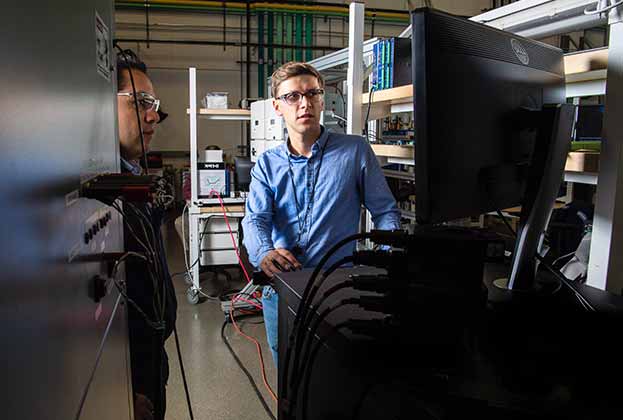European clusters: key drivers
The UK is at the forefront of life sciences in Europe. As a nation, the UK has two of the top five global universities and attracts the lion’s share of venture capital (VC) and private equity (PE) funding on a European basis. As a result, the UK is home to some major life science clusters and research hubs. However, an element of disruption to life science organisations’ operations is expected if a mutual agreement is not found between the UK and Europe post-Brexit. According to KPMG, one large pharma company has calculated the cash flow hit to be c. £200m per annum. What’s more, with the increasing allocation of VC targeting operations in Europe, we believe that continental life science clusters will see significant growth in the near term, creating increased demand for life science real estate.
Knowledge
Academia, research and brainpower is undeniably a key driver for life science clusters. Proximity to best-in-class research universities and hospitals is paramount and dictates the location strategy of large life science occupiers. These academic institutions also produce ‘spin-out’ start-up companies which require real estate (an incubator or established space) in proximity to larger organisations or research hubs. A key indicator for academia is the major universities in Europe. Of the top 10 universities in Europe, seven are located in the UK. However, ETH Zurich, LMU Munich and Karolinska Institute (Sweden) all feature in the top ten.
Funding
VC and PE funding are key indicators to identify the key life science clusters throughout Europe. VC funding for life science companies in Europe (excluding the UK) has reached €15.5bn over the past five years, marking annualised growth of 16% per annum over the same period. The BioValley region of France (€1bn), Switzerland (€895m) and Germany (€1.1bn) has led the way in 2020 as investors are committing further capital to growth companies.
Looking more closely at PE flows, €66.7bn of capital has been raised since 2015 (annualised growth of 24% pa), and it is these companies where we have traditionally observed rapid growth in company headcount. Germany (€13.8bn), Switzerland (€12.8bn) and France (€10.0bn) headquartered companies have been the main contributors, and outside the BioValley region, Italy (€6.0bn) and Netherlands (€4.8bn) are among the most active countries for PE during the last five years.
Looking at the research and development (R&D) spend of the ten largest European pharmaceutical companies, R&D spend for these institutions is greater than 14% of revenue on average (latest data is 2019). Sanofi, Boehringer Sohn, Merck and Allergan all increased their R&D budget on 2018 levels. On a global basis, five of the top 10 are located in Europe, with three continental HQs.
Government Support
Government support is key to establishing a life science cluster. A strong life science campus requires engagement from both public and private stakeholders in order to ensure sufficient local support and funding. Covid-19 has placed healthcare, research and, in turn, the life science sector at the forefront of every European government’s agenda. Any stigma attached to big pharma has been dismantled in the wake of Covid-19 and governments will show increasing support of bioscience advancement. This is a welcome development.
With a focus on BioValley, we examine three major European life science nations’ government support for the sector.
Switzerland
In 2019, Switzerland topped the Global Innovation Index. It is a country founded on a stable political and economic environment, strong academic institutions and optimum collaboration between the public and private sector. The Swiss government has spent an average of 3% of GDP on R&D over the past five years. The Swiss National Science Foundation (SNSF) allocates research funding and supports the domestic life science sector. The budget for 2021–2024 is c.CHF4.60bn (€4.29bn), an increase of €500m on the last period.
Germany
In 2019, Germany ranked 9th in the Global Innovation Index. Germany’s federal government has long supported scientific innovation and research, both domestically and in association with other nations. There are more than 1,000 publicly financed research institutions and 240 higher education institutions with eight universities in the Top 100 list, two of which are in Munich. Germany’s R&D spend has more than doubled in the last 20 years and aims to reach 3.5% of GDP by 2025.
France
In 2019, France ranked 16th in the Global Innovation Index. France is a highly collaborative nation in terms of science programs with its largest partners being the US and EU. Whilst domestically, over 2% of GDP is spent on R&D. Through the Future Investments Programme (PIA), France has invested €45bn since 2010 into higher education and research to harness innovation.
Occupier activity
Corporate investment is creating new occupier demand within the bioscience industry. Roche Pharmaceuticals signed for 11,000 sq m in 2019 in Paris IDF, while medical technology Medtronic leased 4,610 sq m in Paris IDF in 2020. As a trend, we expect to see increased leasing activity on the continent from US companies due to a comparatively cheaper labour force. Increased PE & VC activity and potential re-locations or satellite offices as a result of Brexit will also drive take-up. Central Eastern Europe (CEE) has observed comparatively lower levels of corporate investment compared to the BioValley, although higher levels of pharmaceutical production take place in the region. For example, pharmaceutical giant Bayer committed to 3,200 sq m in Budapest earlier this year, after signing for 3,350 sq m in City West B1, Prague and a further 3,000 sq m in Solna, Stockholm in 2019.
Investment activity
Investor demand has intensified for long, secure income streams during 2020, which has pushed the European life science sector to the forefront of buyers’ wish-lists. Investment into European Research and Development (R&D) facilities reached €889m during the first three quarters of 2020, in line with the 10-year annual average. A dip in investment activity during the second and third quarters of 2020 can be attributed to an inability to view assets due to travel restrictions as well as a shortage of willing vendors. Nevertheless, cross border investors are taking an increasing proportion of the market, accounting for 56% of total volumes in 2020, up from 51% in 2019, and we are observing yield compression for prime assets in the search for long-dated income.
Read the articles within Spotlight: Life Sciences – Trends & Outlook below.
.jpg)



.jpg)

